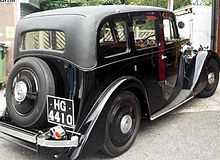Lanchester Light Six
| Lanchester Light Six | |
|---|---|
 Four-light sports saloon 1935 example | |
| Overview | |
| Manufacturer | The Daimler Company Limited |
| Also called | BSA Light Six |
| Body and chassis | |
| Body style |
Saloons and coupés other styles to special order[1] |
| Layout | FR layout |
| Related | Lanchester Ten, BSA Ten |
| Powertrain | |
| Engine | 1378 cc[2] |
| Transmission | Daimler fluid flywheel and Wilson four-speed preselective self-changing gearbox[2] |
| Dimensions | |
| Wheelbase |
(8'6½") 102.5 in (2,604 mm) and track (4'0½") 48.5 in (1,232 mm)[1] |
| Kerb weight | 22cwt |
| Chronology | |
| Predecessor | none |
| Successor | Fourteen Roadrider |
| Lanchester Light Six engine | |
|---|---|
| Overview | |
| Manufacturer | The Daimler Company Limited |
| Also called | BSA Light Six |
| Combustion chamber | |
| Configuration | 6-cylinder in-line |
| Displacement | 1378 cc[2] |
| Cylinder bore | 57 mm (2.2 in)[1] |
| Piston stroke | 90 mm (3.5 in)[1] |
| Cylinder block alloy | Cast-iron with integral head, mounted on a two-piece aluminium crankcase[2] |
| Cylinder head alloy |
Integral head with block Aluminium-alloy pistons[2] |
| Valvetrain | ohv operated by pushrods from a chain-driven camshaft[2] |
| Combustion | |
| Fuel system | S.U. carburettor |
| Fuel type | Petrol[2] |
| Oil system | full pressure lubrication[2] |
| Cooling system | water thermostatically controlled with pump and fan to radiator[2] |
| Output | |
| Power output |
34 bhp (25 kW; 34 PS) @3,600 rpm[2] Tax rating 12.09 hp[1] |
The Lanchester Light Six was a small luxury car in the twelve tax horsepower class manufactured for The Lanchester Motor Company Limited by BSA subsidiary The Daimler Company Limited. Announced in September 1934[1] it was the better-finished version of an almost identical pair the other half being the BSA Light Six
It followed the Lanchester 15/18 introduced three years earlier and Ten introduced in October 1932 as the third break away from previous Lanchester large cars.
This model was to become the Fourteen or Roadrider in 1937
Engine
The new engine design was on the same general lines as the Lanchester Eighteen (not 15/18) though with a chain-driven dynamo and a much reduced bore and stroke taking down the swept volume from 2,390 cubic centimetres (146 cu in) to 1,378 cubic centimetres (84 cu in)
Chassis
The larger twelve horsepower six-cylinder engine was mounted in the chassis of the ten horsepower four-cylinder Lanchester Ten. Steering was by cam and lever, brakes were mechanical. Tyres specified were 5 inch on 18 inch wheels.
Prices
- six-light saloon and fixed head coupé £365
- sports saloon and streamlined saloon £375
- drophead coupé £390
- Romney coupé by Martin Walter £430 (made to order)
- Tickford coupé by Salmons & Sons £435 (made to order)


References
External links
| Wikimedia Commons has media related to Lanchester Twelve. |